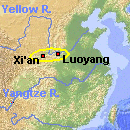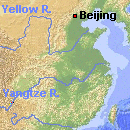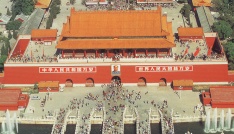1.0 Anyang (Yin)
 Anyang
-or Yin as it was called then- served as capital in the later part of the Shang dynasty which ruled
"China" from the 16th to the 11th century BC. Anyang
-or Yin as it was called then- served as capital in the later part of the Shang dynasty which ruled
"China" from the 16th to the 11th century BC.
The Shang dynasty actually had a total of seven successive capitals of which
Yin was but the last. The records of these capitals were compiled by the
subsequent Zhou dynasty. From these chronicles we know that Shang
established their first capital in the city of Bo in today's Shandong
Province and also that fairly early during this dynasty's 600 years reign
they established a capital in the city of Zhengzhou.
Location

Yin is situated in the fertile plains well north of the Yellow
River but relatively close to the mountains. This is
The first settlers of northern China chose the fertile and water rich area
around and south of the lower reaches of Huanghe, the Yellow River.
Numerous villages and cities have existed with few natural defenses
but the weapons of the time required little more than a wide and deep moat around a settlement to
ensure sufficient protection from would-be attackers (see village model
right).
The first "capital" has been found close to today’s Anyang.
It dates back to year 1400-1300 BC and served as capital for the Shang
dynasty. Logistics and transportation was less important with an abundance of food
nearby. The lack of natural defenses was made up for by constructing city
walls mostly made from rammed earth.
Organized Societies: Protection over Food (1000 BC - 1279
AD)

The proliferation of halberds, cavalry, chariots and armor raised the bar for security.
Organized  societies needed capitals for the government. Rulers needed protection for themselves
and their followers. About year 1000 BC the Western Zhou dynasty chose the more defensible area
around today’s Xi’an over the open plains of Anyang.
societies needed capitals for the government. Rulers needed protection for themselves
and their followers. About year 1000 BC the Western Zhou dynasty chose the more defensible area
around today’s Xi’an over the open plains of Anyang.
Better protection came at the cost of accessibility to sufficient
food but sophisticated irrigation
projects and grand canal constructions delayed the inevitable for
centuries.
The Xi'an area in today's Sha'anxi province remained favorite capital location for all China's main
dynasties until Kublai Khan came along from Mongolia and changed all of that in the 13th century.
Luoyang was a constant "backup" capital when needed for
defense or food reasons.
Modern Societies: Geopolitics over Protection (1279 AD - )

Khubilai Khan
(right) established his capital in Dadu (today's Beijing) signaling his
dominance over China and yet not too far south to still be north-south
centered when including his homeland, Mongolia. But after Kublai Khan
Beijing would not seem to be a logical choice for capital -not even today. It is far from China's commercial center of Shanghai.
It is far to the north of China's geographical center. It has a dry climate and is short of water.
Food and other necessities must be transported to it from the far south. It is
plagued by drifting sands from the Gobi desert. Why on earth then would
anyone choose Beijing as capital? (See box right).
China’s Many Capitals
Beijing, Anyang, Xi'an and Luoyang are however only 4 capitals out of many. In fact, since China's
Neolithic period a total of 15 cities have made it into China’s history as “capitals”. Most of these other
11 cities
held the honor of being capital during periods of disunion, invasion or infighting.
Many of them
were even concurrent capitals.
 |
Beijing's Tian'anmen Gate |
Click on the picture left for a map of all the capitals. The map also shows during which dynasty(-ies)
a city was capital.
The total list of capitals is elsewhere on this page (see box top right). Each capital has its own unique and exciting
tale. Some have dwindled into history's dark, forgotten chapters. Others
carried the Chinese baton in times of war and hardship and yet remain
almost unknown to non-Chinese people. Click on a name to learn more of the glory of
each city as a
capital.
We'll let this brief introduction end with a picture of the well-known
Tian'anmen Gate located just north of Tian'anmen square. The gate is also
the southern entrance gateway to the Forbidden City lying further north.
The Forbidden City served as court from 1417 till 1911 and is located in
the center of Beijing.
|


